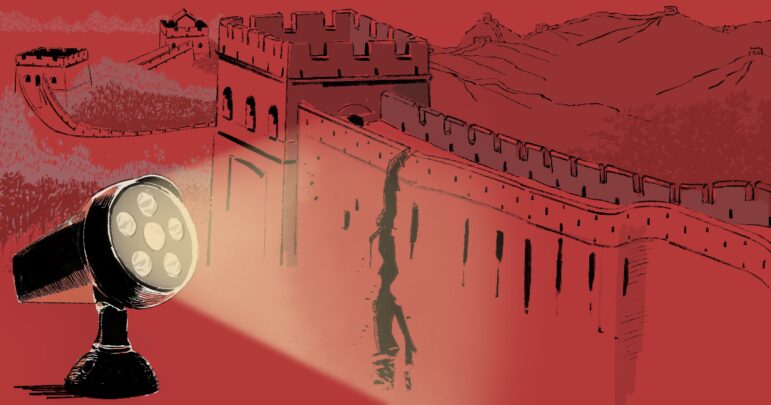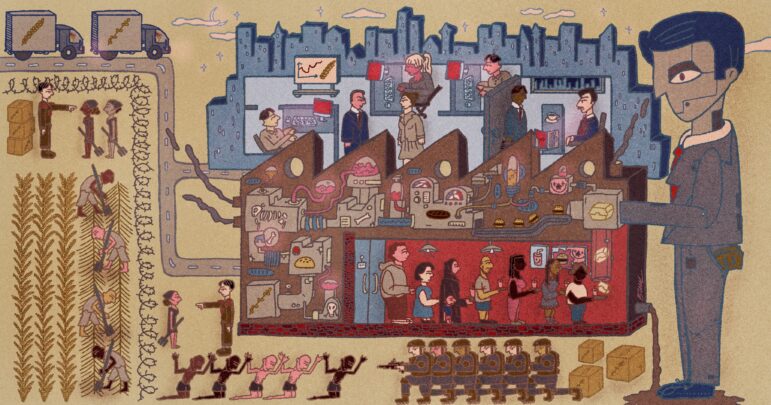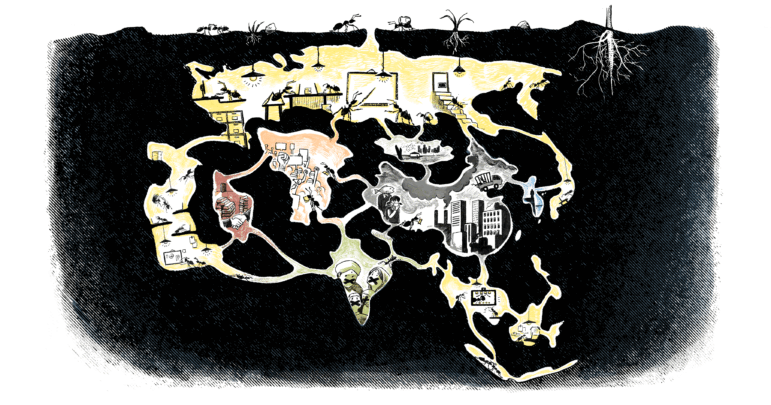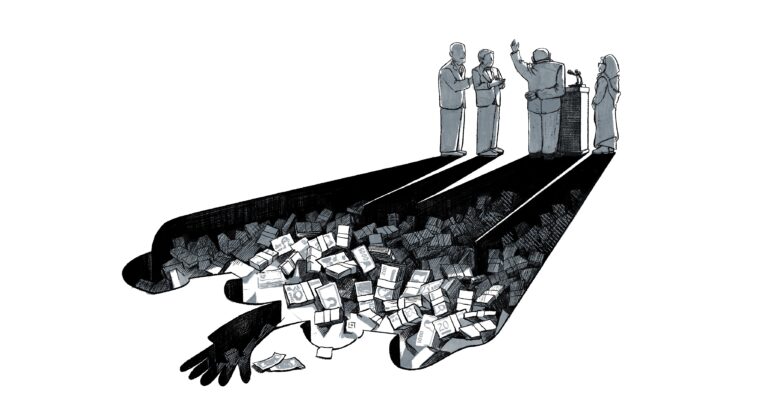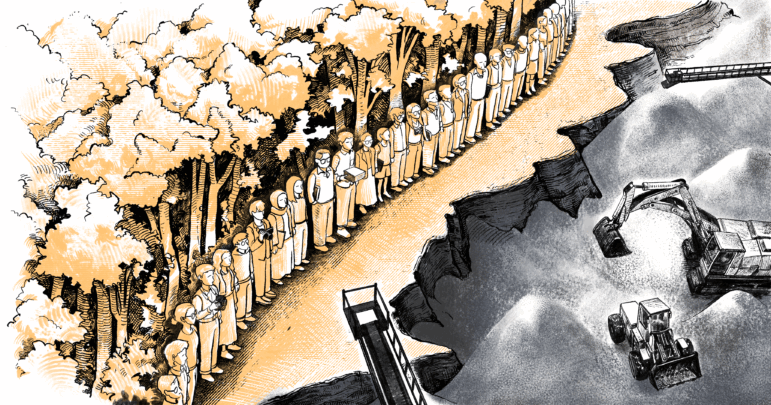

Illustration: Nyuk for GIJN
How Newsrooms are Uncovering Asia’s Climate and Environmental Crises, from Illegal Sand Mining to Sinking Cities
In the common consciousness, sand is usually shorthand for beach holidays, evoking periods of rest and relaxation. But it also plays a vital role in a major environmental issue: as a key substance in the making of concrete, huge amounts of sand are mined for urban construction schemes or for massive land reclamation projects.
In 2023, journalists Budhy Nurgianto from Indonesia and Nabilah Said from Singapore worked together to expose how the land reclamation process “guzzles an alarming amount of sand, causing massive environmental damage,” all while feeding the transnational criminal syndicates trading in illegal sand.
Their reporting was part of Beneath the Sands, a vast cross-border investigation that, in 2024, won an award for Excellence in Journalistic Innovation from the Society of Publishers in Asia.
Across Asia, journalists are coming together to link climate and environmental harms across borders — a tactic that is enabling them to dig deeper into cause and effect, and trace environmental harms from where they are happening on the ground up to the powerful forces that are behind the activity.
The sheer size of the continent, and its vast population, makes it responsible for a majority of global greenhouse gas emissions. And it is also a place where key commodities linked to climate change or environmental crimes — like fossil fuels, palm oil, soybeans — are consumed. Then there is the money linked to those trades, and those that go under the radar and make the region a key conduit for illegal activities and smuggling.
Reporters working to uncover some of these hidden stories are doing so in an incredibly challenging environment. Deteriorating press freedom is a major issue for investigative reporters in all fields, while across Asia, journalists covering environmental issues are being censored. The situation is such that Reporters Without Borders calls Asia one of the “danger zones” for environmental reporters.
Some reporters working on environmental investigations have been arrested or faced long prison terms, while in India, Shubham Mani Tripathi, a reporter investigating the sand mining mafia, was shot dead in 2020. And in places like Myanmar, which is seeing a huge expansion of rare earth mining, reporters working in areas with active conflicts often find putting their real name on a byline is too great a risk.
By their very nature, many of the most urgent environmental issues transcend borders, and a good investigation requires working in different countries. But language, distance, press freedom, and lack of resources make collaboration more challenging. Despite this, locally-led investigations have been able to link issues such as illegal sand mining, soil health, sea level rise, and climate change, enabling information sharing and real impact.
GIJN spoke with organizations, editors, and journalists who are finding ways to overcome the barriers to connect reporters and investigate critical topics across this diverse region.
Collaborative Model for Asia
Sam Schramski, special projects editor at the Earth Journalism Network (EJN), says that while there is immense potential in cross-border collaborative environmental reporting in Asia, there are also many challenges.
“Much of it [cross-border reporting], traditionally, comes out of Europe or the United States, and it’s not necessarily translatable to the Asia-Pacific for a lot of reasons,” Schramski says.
In just one region, like Southeast Asia, you can find dramatically different levels of economic development, democratic governance, or press freedom. Dive deeper, and you can find that even individual countries can have dozens of languages, distinct religious or ethnic groups, all factors that can make on-the-ground reporting or data gathering challenging.
EJN has tried to overcome the challenges, building on a history of media development work in the region, and drawing on a strong network of country coordinators and existing relationships with a diverse pool of journalists and media outlets.
“[It was] something that we felt we needed to dive into for the sake of our partners who hadn’t been able to participate in collaborations,” Schramski explains. “For us, it was building on our existing network [to make] a cooperative ecosystem.”
EJN has run several investigations over the past decade and their latest, Ground Truths, received an Honorable Mention in the 2025 SOPA Excellence in Reporting on the Environment awards. It brought together 11 media outlets in Asia to explore topics around soil degradation.
“We had heard from a number of journalists that soil was really undercovered,” Schramski says.
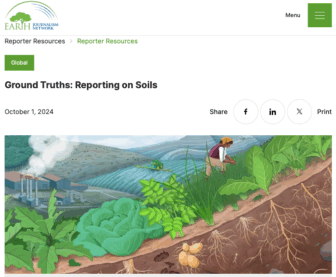
The Earth Journalism Network’s multi-part investigation brought together 11 media outlets across the continent to look into the causes and far-reaching implications of declining soil health. Image: Screenshot, EJN
What seemed like a niche, local story ended up having wide-ranging regional implications. Across Asia, poor soil management practices, rapid urbanization, unsustainable agriculture, deforestation, desertification, mining, and the climate crisis have worsened soil degradation. For Nguyen Thu Quynh, a Vietnamese journalist, there was real appeal in taking a collaborative approach.
The impact of soil degradation on public health is under-reported, Nguyen told EJN, and covers a variety of issues like chemical fertilizers and pesticides contaminating soil, surface water, and groundwater.
EJN enabled the sharing of sources, including scientific data, across countries, allowing for comparison and identification of key issues. But each outlet was allowed to frame their story for their audience.
For example, in Vietnam, Nguyen’s story, which involved field reporting, scientific analysis, and data gathering, focused on declining soil health and farming productivity in the densely populated Mekong River Delta. Meanwhile, in India, Shagun Kapil’s investigation for Down to Earth focused on the soil fertility crisis and its impacts on food security, exploring what was happening in the breadbasket of India, the once-rich farming regions of Punjab.
Kapil says the soil represents a “common thread between humans, animals, biodiversity, and environment.” She adds that journalists can better frame their stories “by making clear the critical link between soil health and broader issues, such as the availability of micro and macro nutrients like zinc and iron in the soil, and the nutritional status of people in a particular region.”
Why a Local-First Approach Matters
Since 2020, the Environmental Reporting Collective (ERC) has been leading Asia-focused cross-border collaborations, developing a unique model that Ian Yee, the executive director, says matches the reality of working in a complex, challenging region.
“We connect journalists in each country who are interested in these issues, support them, give them the tools and funding they need to pursue a story, and then make something, collaboratively, that’s bigger,” Yee explains. “We are trying our best to create a culture where collaboration can flourish here. We haven’t always gotten it right, but we like to think that we are on the right track.”
ERC is based in Asia, officially in Indonesia, but with core team members spread across the continent. This is a marked difference from most global investigative reporting organizations, which are primarily based in North America or Europe.
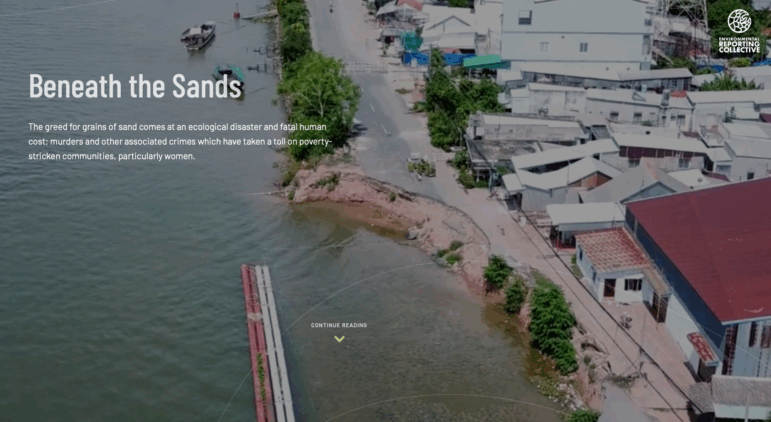
The award-winning cross-border reporting project Beneath the Sands exposed how widespread sand dredging has ecological impacts on local populations and a significant human cost. Image: Screenshot, ERC
The group runs a single, cross-border collaboration every year, usually on a topic decided during a global convening of network members. So far, it has released three award-winning investigations in addition to Beneath the Sands; Pangolin Reports, which explored the threads linking the trade of pangolins from the tropics, via Southeast Asia, to China and Hong Kong; Oceans Inc. on overfishing in the South China Sea; and Greed of Green, which investigated the environmental and social impacts of the boom in critical mineral mining for clean tech.
“Our preference is for the stories to be published in the outlets in the region itself. That should be good enough,” Yee says.
Beneath the Sands, published in 2023, documented sand-related crimes in Vietnam, Sri Lanka, Nepal, the Philippines, and India, with stories published in six Asian outlets. It took a local issue — sand mining in beaches or rivers — and showed how the issue crossed borders, being a vital component in mega construction projects in Asia’s big cities.
For each investigation, ERC publishes collaborative global stories in English, which tie together the main themes from various journalists working on the ground across Asia. The organization also offers editorial, financial, and logistical support for teams working on collaborative stories. In the end, freelancers and media outlets are free to publish their own stories in local media or local languages. Coordinating all that, across a diverse region, requires patience, Yee notes.
“Managing expectations is probably the most important thing,” he adds. “We need to be able to be flexible, and have empathy for fellow collaborators.”
Being in the region has also allowed Yee to see how much harder investigative reporting has become. While Asia is not the only part of the world facing press freedom challenges, the often unique local circumstances in countries like Myanmar, China, Vietnam, or the Philippines, make a local approach even more important, he points out.
“There are journalists who are continuing to do the work despite the lack of funding, increasing risks, and challenges,” Yee says. “It is really an urgent time for the region. We need support. We need more help.”
Covering China’s Role
A big challenge in Asia is how to report on China. The world’s second-most populous country is Asia’s largest economy, trading partner, and investor, yet it ranks third-worst in the world for press freedom and lacks a true independent media. In many cases, collaborations have to rely on journalists outside China due to the risks journalists inside the country face and the barriers that limit the ability of foreign journalists to report on the ground.
In particular, reporting on regions like the Uyghur homeland of Xinjiang, a key hub in solar component production, and Tibet, where China gets huge swathes of its lithium and has huge mining operations, has proven to be almost impossible. Both regions remain almost entirely inaccessible to either foreign or even independent Chinese journalists, and locals face the risk of reprisals for even speaking with, or sharing data, with reporters.
Many collaborations, including ones led by ERC and EJN, have turned to The Initium as their Chinese-language partner. Now based in Singapore, the outlet was founded in 2015 and focuses on publishing longform and investigative journalism for Chinese-language readers around the world.
“Often the case is, because we have very strong roots in mainland China, Hong Kong, and Taiwan, if a project sees an interest in having a Chinese perspective, Initium often comes up in their search,” says Lulu Ning Hui, a longtime editor and now the publisher at Initium. “If we are able to find something that we think is worthwhile telling and of interest to our subscribers, then we decide to invest in it.”
The Initium is able to navigate some of the challenges of working in China and has a network of freelancers who have participated in collaborations. Climate and environment is one of their focuses, and one that Hui has found often intersects with other issues.
“Climate change is one of our key reporting focuses also, because it relates to everything else we cover, like gender, technology, immigration, politics, or society,” Hui adds.
One recent story published by Initium, a data-driven investigation on sinking cities and sea-level risk in China, won a SOPA award this past year, and is the type of story Hui is especially proud of.
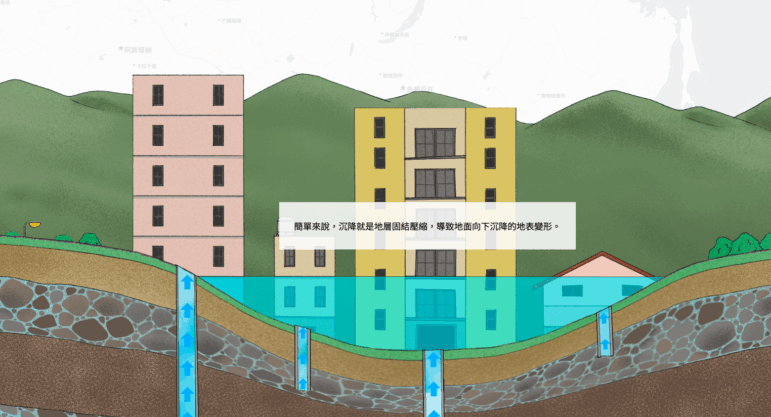
Singapore-based Chinese news site The Initium recently won a SOPA award for its reporting on the threat of sea-level rise and sinking Chinese cities. Image: Screenshot, Initium Media
“I think it’s a rare example of bringing a complex subject matter to our audience in a way that’s very accessible,” she says.
Still, as a small newsroom with limited resources, The Initium can’t fulfill the great demand for covering China and its growing role around the world.
“I do understand, given China’s political and societal situation, our access and our understanding can be, maybe, very rare,” Hui says. “I do wish there was a richer landscape for collaboration between Chinese journalists and other journalists, and we try to promote that.”
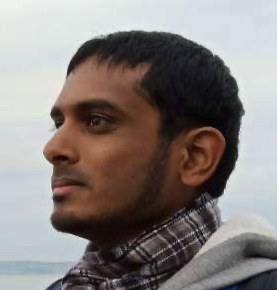 Nithin Coca is a freelance journalist, primarily publishing in-depth features and investigations about Asia. His work often focuses on intersectional issues, linking, for example, climate change and human rights, or supply chains and environmental degradation. He has been awarded fellowships from the Solutions Journalism Network, The Pulitzer Center, and Journalism Fund EU, and his features have appeared in Vox, The Financial Times, Foreign Policy, Al Jazeera, The Nation, and Coda Story.
Nithin Coca is a freelance journalist, primarily publishing in-depth features and investigations about Asia. His work often focuses on intersectional issues, linking, for example, climate change and human rights, or supply chains and environmental degradation. He has been awarded fellowships from the Solutions Journalism Network, The Pulitzer Center, and Journalism Fund EU, and his features have appeared in Vox, The Financial Times, Foreign Policy, Al Jazeera, The Nation, and Coda Story.
Illustration: Nyuk was born in 2000 in South Korea. He is currently studying at the Department of Applied Art Education at Hanyang University in Seoul, where he also works as an illustrator. Since the exhibition at Hidden Place in 2021, he has participated in various illustration exhibitions. He is mainly interested in hand drawing, which represents the value of his art world.

